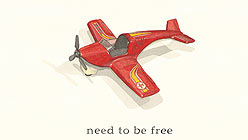There’s more than a touch of melancholy on display at Electric Works this month; something I would argue is in keeping with the overall influence of comix (á la Art Spiegelman) on Paul Madonna and Ian Huebert. Spiegelman used the word ‘comix’ because he wanted to stress that his creations were not just humorous illustrations, but a new narrative technique: a ‘comix-ture’ of words and images that relied on the tension between what was being said and what was being illustrated.
I doubt that Speigelman was the first graphic artist to whom this occurred, but he managed to combine this insight with the idea that comix could broach material just as serious as any other novel, and arguably reinvented the comic book in America. He also introduced notes of irony, self-consciousness and melancholy that still permeate the genre, and it’s this tone that marries Madonna’s Album 01: In Which Era Will You Get Stuck? exhibition with Huebert’s Drawing from the Plains.
Madonna’s drawings are supporting documents to a limited-edition book, also called Album 01, published jointly by Electric Works and the Paul Madonna Studio, and I think the show feels a little rough around the edges for this reason. The book is more coherent than the gallery installation — for example, it includes most of the stages that Madonna’s drawings underwent, providing a larger frame of reference for the artist’s ideas. “Balsa Planes 1 – 5,” which is currently my favorite piece, went through four iterations before it became the drawing that hangs on the gallery wall.

“Balsa Planes 5” (2009), Paul Madonna, image courtesy Electric Works
While the final image is evocative on its own, when you see the entire five-panel series of wooden gliders and their paper plane counterparts playing out an ambiguous scene that could be a battle (or not), “Balsa Planes 1 – 5” becomes a meaningful synecdoche for the tension present in the rest of Album 01.





